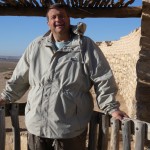Tel Beer Sheva
In Judges (20:1) and First Samuel (3:10; 11:17; 24:2) Dan to Beer Sheva’ is a stereotyped expression for the limits of the land of Israel. Beer Sheva’ was important for its association with the Patriarchs. The name is explained as the “Well of the Seven” or the “Well of Oath.” It is a rugged location perched in the Negev Desert just beyond the view of the southern edge of the Judean Mountains.
Tel Beer Sheva is located only a few miles from the modern town of Beer Sheva. It was a place of oath and promise. Abraham found security for his people at the well he dug. Isaac built an altar to the Lord. Jacob received a vision to take his family to Egypt. This was a real frontier settlement where a lot of activity between the Patriarchs and the surrounding nations of the Philistines and Amalekites took place.
King David built up Beer Sheva’s fortifications in the early part of his reign. After the fortifications the city was a lot more tranquil than at any time in its history. Then, it was destroyed by King Shishak and later rebuilt. The next mention of Beer Sheva’ is Amos’ condemnation of the pagan worship. Hezekiah destroyed the altar used at Beer Sheva’s worship center. It did not conform to Biblical directions.
People like religion. The pomp and feel good experience of doing things in a way that doesn’t conflict with their private life. That’s what religion is, rote practice that doesn’t interfere with one’s heart. On the other hand, following Christ is an inner change. Jesus gives us a new heart and makes us new creations.
Abraham worshipped the Lord God. The people of Tel Beer Sheva created a cultic practice of religion that worshipped the creation and not the creator. They liked to do what they wanted to do. They refused to obey the Lord. Cut stones and an altar with horns separated the people of Beer Sheva from a Holy God. Look to your life. Is there some created thing that is separating you from the Lord Jesus?
A walk along the walls offers a spectacular view of Mount Carmel and Haifa, Galilee and the old city. The citadel museum of heroism, built on top of the crusader foundations, commemorates the Jewish freedom fighters imprisoned by the British. Layers of diverse cultures peer through the ancient walls of a subterranean complex, which was excavated in the 1950’S.
The city is more than 4,000 years old. During biblical times the city was under Canaanite control. It is mentioned in ancient Egyptian scrolls from around 1800 BC. The city assumed great importance on the trade route between Egypt and Syria.
